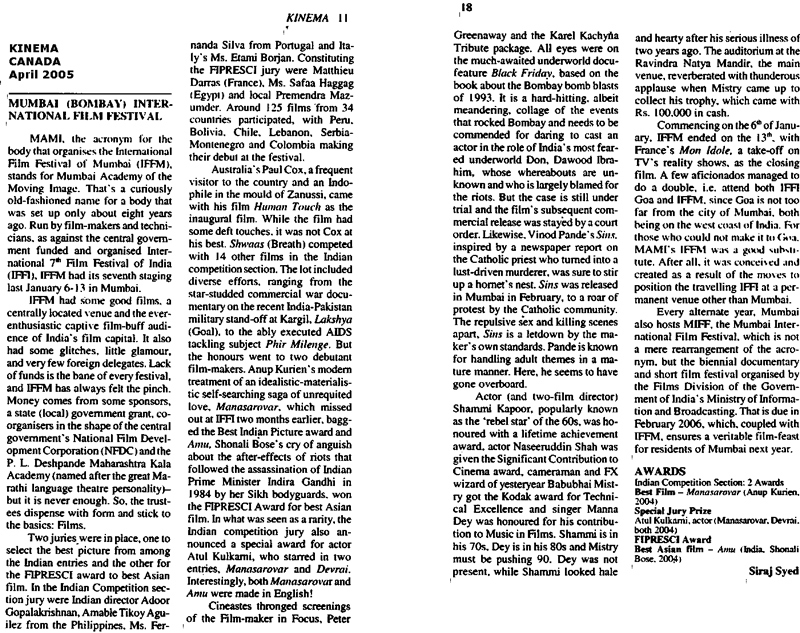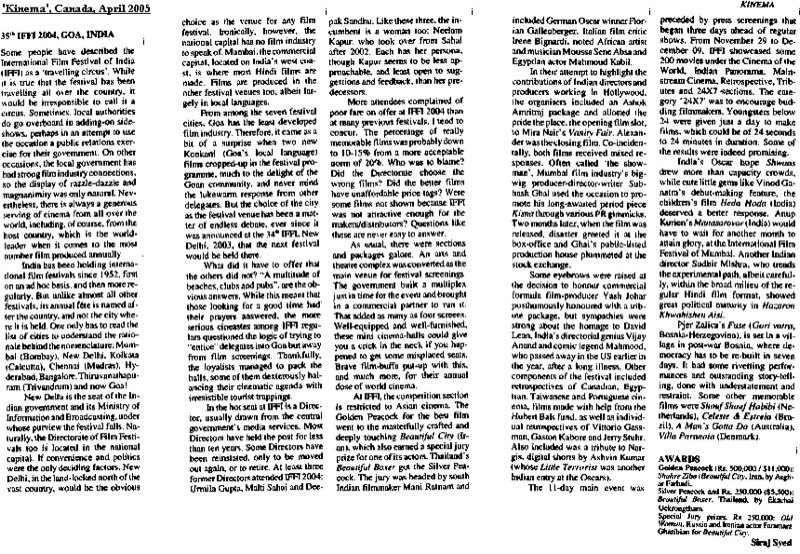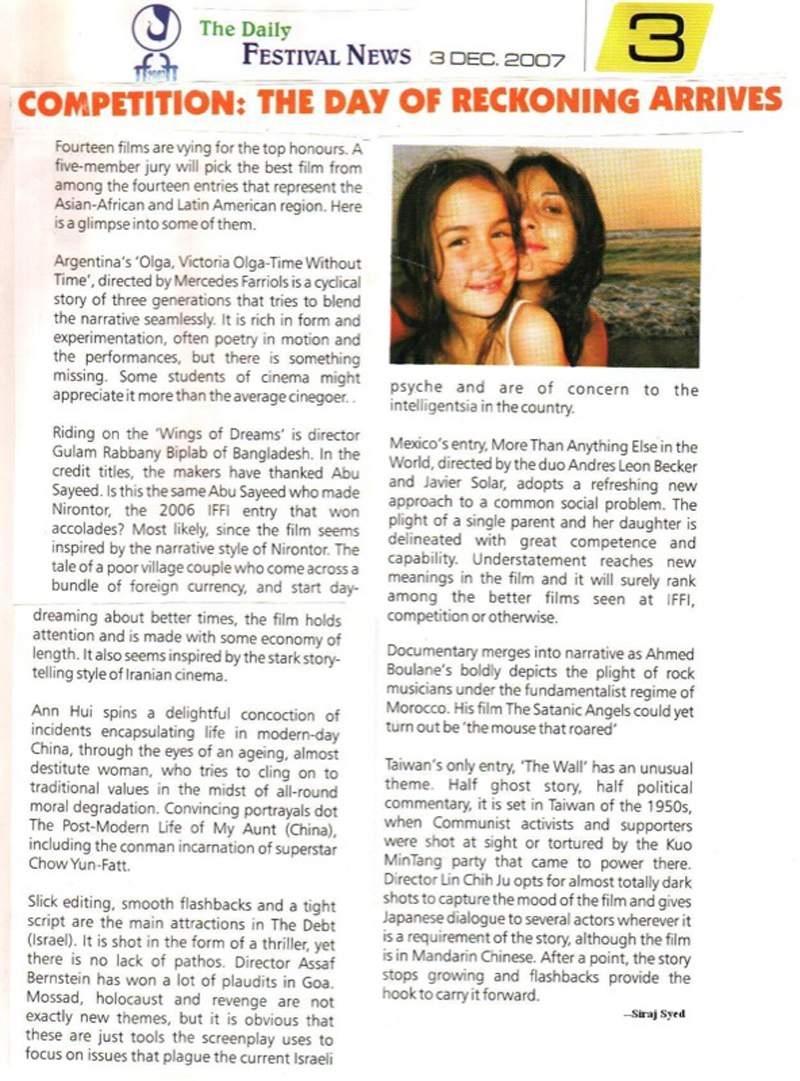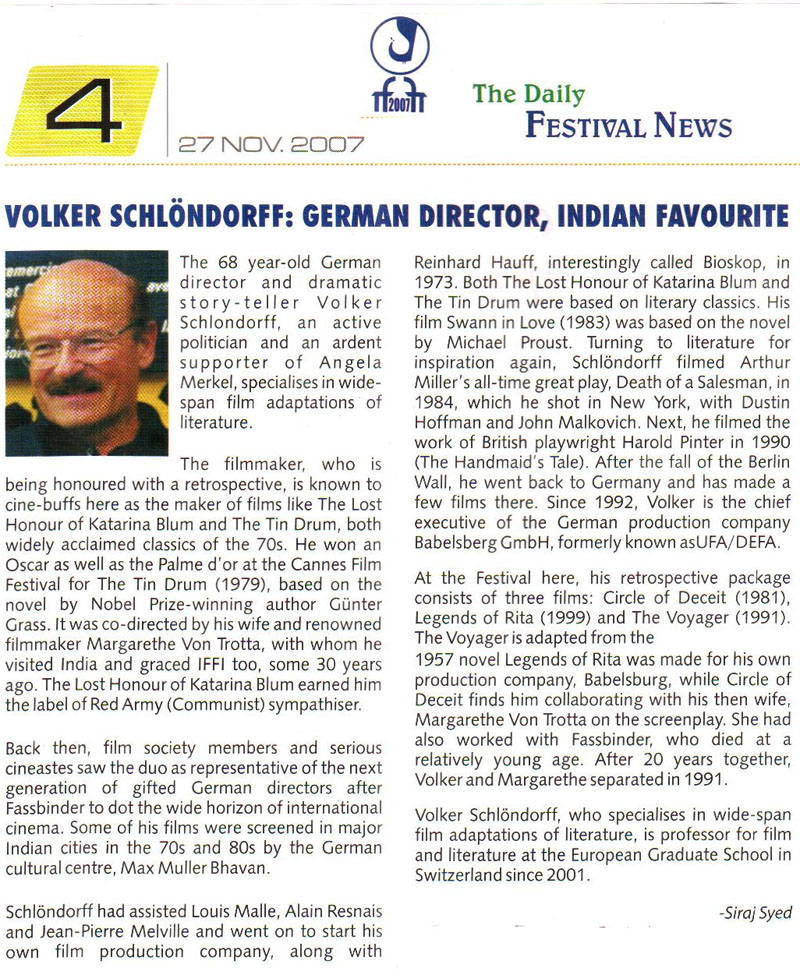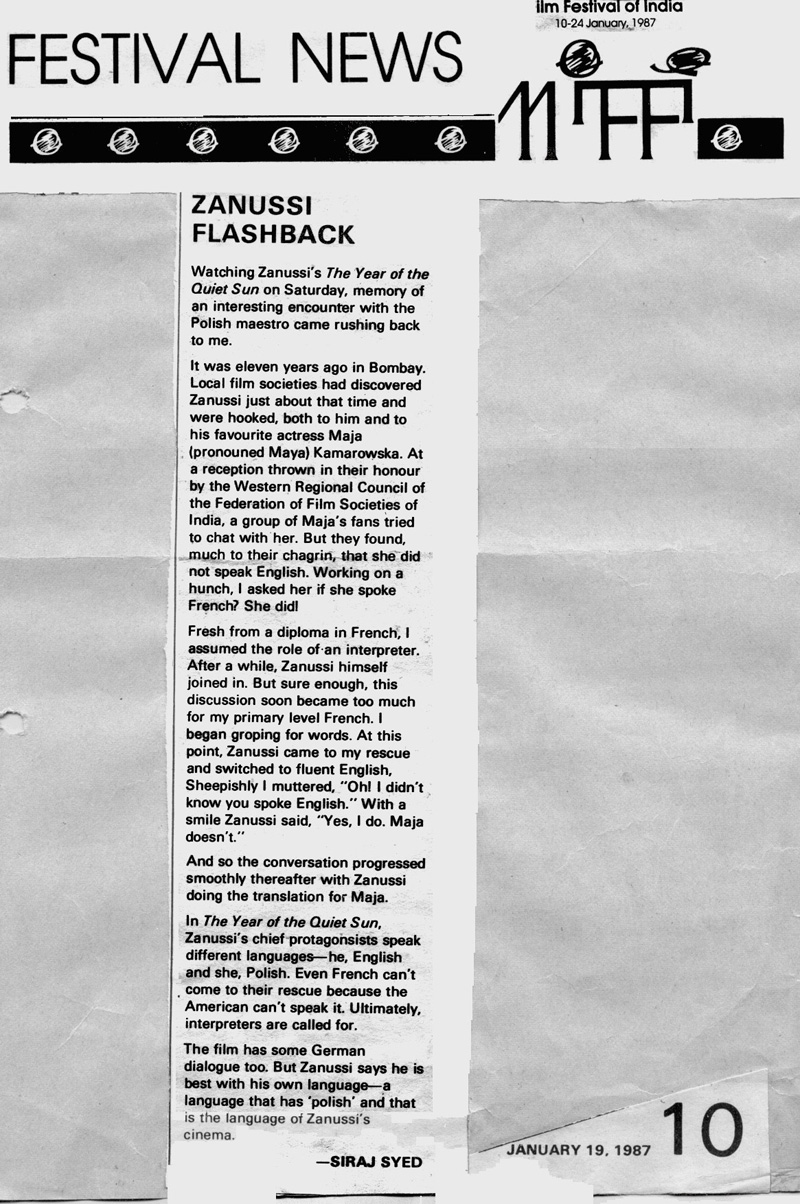|
|
||
|
Pro Tools
FILMFESTIVALS | 24/7 world wide coverageWelcome ! Enjoy the best of both worlds: Film & Festival News, exploring the best of the film festivals community. Launched in 1995, relentlessly connecting films to festivals, documenting and promoting festivals worldwide. Sorry for the disruptions we are working on the platform as of today. For collaboration, editorial contributions, or publicity, please send us an email here. User loginActive Members |
Siraj SyedSiraj Syed is the India Correspondent for FilmFestivals.com and a member of FIPRESCI, the International Federation of Film Critics. He is a Film Festival Correspondent since 1976, Film-critic since 1969 and a Feature-writer since 1970. He is also an acting and dialogue coach. @SirajHSyed  Interstellar, Review--Gravity of the situation: Galactic Wormhole or Earthy Dust-bowl?
Interstellar, Review-- Gravity of the situation: Galactic Wormhole or Earthy Dust-bowl? Mainly based on the scientific theories of Kip Thorne, Interstellar is a film that Steven Spielberg was to direct, and took about nine earthly years to land on planet IMAX (probably the last one to be shot on IMAX 15/70 format), courtesy spaceships Warner and Paramount. Thorne is an American Caltech physicist theoretical physicist who has written academic books on general relativity, collaborated with Carl Sagan and Stephen Hawking, and is one of the world’s leading experts on all things gravitational. Lynda Obst commissioned the original treatment and Steven Spielberg came aboard in 2006, when Paramount owned DreamWorks, after Obst became intrigued by Thorne’s theory that ‘wormholes’ exist and can be used for time travel. Spielberg set Jonah Nolan to write the script, which made it easy for Christopher Nolan to come aboard, after Dreamworks moved to Disney, and Spielberg left the project. In the near future, the earth is no longer able to sustain humanity. Crops are routinely ravaged by blight, dust storms scour the land, and mankind has regressed to an agrarian society. Cooper, a former NASA test pilot and engineer-turned-farmer, lives with his family, including his father-in-law, son Tom, and ten year-old daughter Murphy—lovingly called Murph—who believes their house is haunted by a ghost that is trying to communicate to her. Challenging Murph to prove the ghost's existence through scientific inquiry, Cooper discovers that the ‘ghost’ is directing them to a secret NASA installation. They head for the place, where they are brought face-to-face with physicist Dr. Brand, who is working with a skeletal team of scientists, to salvage NASA’s reputation, ruined by what people believe were several fake missions involving billions of dollars in taxpayers’ expense. Brand reveals to Cooper that humanity's fight to survive is a losing battle, and proposes that the solution is to colonise another galaxy. Cooper is recruited to pilot Endurance, in search of a viable home world by way of a wormhole that has formed off Saturn. Endurance will follow the Lazarus Mission, a series of manned probes sent through the wormhole to survey potential planets as to their long-term sustainability. The data from Lazarus has given NASA three potential candidate locations, planets named Miller, Edmunds and Mann, after the astronauts who went there in search. Cooper's decision to join Endurance breaks Murph's heart, as Cooper could take decades to return, or never come back at all. The two part on bad terms. He joins Brand's daughter Amelia, physicist Rommily, geographer Doyle, and a multi-purpose robot called TARS, on a two-year trip to Saturn, before crossing over into the new galaxy. While traversing the wormhole, Amelia encounters an extra-dimensional presence that she believes has placed the wormhole to save humanity. Once through, Endurance follow the signal left by Miller's expedition, but the team quickly encounter a problem: the candidate planet is in close proximity to Gargantua, a nearby black hole, and due to its gravitational pull, time on the surface is distorted. Cooper proposes a solution to minimise the amount of time spent on the surface. They discover that the planet is inhospitable, as giant tidal waves race across its surface. Doyle is killed, Amelia barely saved and the ship is inundated with water, as the crew attempt to retrieve Miller's probe. When they return to Endurance, they discover that twenty-three years of relative time have passed. Back on earth, Murph is now an adult and has joined NASA, where she attempts to solve a physics problem that has troubled Brand for years: the question of how humans can escape the earth's gravitational pull, en masse. Brand's health deteriorates and he admits that there is no hope Endurance will ever return, instead putting his faith in Plan B, a mass repopulation project using fertilised embryos to start human-kind over on a suitable planet. With the time-consuming mission to retrieve Miller's data having consumed valuable resources, Endurance is forced to choose between following Mann or Edmunds, the remaining two options. Cooper and Amelia clash, with Cooper accusing her of being compromised by her emotional attachment to Edmunds, her lover. On Cooper’s command, the crew seeks out Mann, finding him on an icy, ammonia-saturated planet, and reviving him from induced deep slumber. Endurance receives a message from Murph, who reveals that Brand lied to them about their mission, and Cooper realises Mann lied about the viability of his planet.
London-born film-maker Christopher Nolan started making 8 mm films from the age of seven, and studied English Literature at University College London, graduating to 16 mm, through borrowing equipment from the college's film department, to make short films in his spare time. His ground-breaking film Memento was inspired by a story his brother had written and told him about during a cross-country trip. Nolan's next project was a remake of the tense Norwegian thriller Insomnia (1997). His 2005 venture, Batman Begins, pleased most audiences. The Dark Knight (co-scripted with Jonathan), truly established Nolan as one of his generation's most formidable film-making talents. Nolan next teamed with Leonardo Di Caprio, Joseph Gordon-Levitt and Ellen Page, for the mind-bending 2008 thriller, Inception. Inception won four Oscars. 2012's The Dark Knight Rises was another big hit. To research for Interstellar, director Christopher Nolan visited NASA as well as the private space program SpaceX. Christopher kept in place Jonathan's conception of the first hour, which is set on a resource-depleted Earth in the near future. The setting was inspired by the Dust Bowl that took place in the United States during the Great Depression in the 1930s. But he revised the rest of the script. Nolan said he became interested in casting Matthew McConaughey after seeing him in an early cut of the 2012 film, Mud. Anne Hathaway was invited to Nolan's home, where she read the script for Interstellar. Other well-known actors eventually joined what would become "an all-star cast". Indian actor Irrfan Khan said he declined a role since he wanted to be in India for the releases of The Lunchbox and D-Day. Naming influences, Nolan cited Metropolis (1927), 2001: A Space Odyssey (1968), and Blade Runner (1982). You can't pretend 2001 doesn't exist when you're making Interstellar." He also said Star Wars (1977) and Alien (1979) influenced Interstellar 's production design: "Those always stuck in my head as being how you need to approach science-fiction. It has to feel used—as used and as real as the world we live in."Andrei Tarkovsky's The Mirror (not Solaris?) influenced "elemental things in the story to do with wind and dust and water". (Quentin Tarantino has compared Nolan to Tarkovsky). For further inspiration grounded in real-world space travel, the director also invited former astronaut Marsha Ivins to the set. Interstellar is one film that is likely to put any cine-analyst in multiple dilemmas. It’s not a masterpiece, but I’ll recommend it to everyone. Is Christopher Nolan ambitious? More than ambitious, but the ambitions are not fully realised. Is it visually stunning? It is visually attractive, but the number of seat/arm grabbing scenes are few in. Does the narrative cast a spell and rivet you? It does, but only in the middle one-third. Is the jargon explained and comprehensible? Yes and no. Too much jargon, too much explaining, and still too much confusion. Is Nolan able to blend his brother’s Dust Bowl Act with his gravity/black-hole/worm enterprise? Not entirely. Does it conform to the space/fiction genre? No, which would be welcome, but then it surfs almost every genre, causing black holes in your absorptive capacity. Are the performances applause-worthy? Largely, no. In 3-4 scenes, yes. Matthew McConaughey as Cooper looks spaced out in most scenes, arrogant in others, and confused in some. While this goes partly with his predicament, there is not enough motivation to justify his behaviour. All the technology and jargon he is confronted with seems to put him ill-at-ease. His accent and diction must take some blame too. Yet, he has his moments of glory, when he plays a loving father. Nolan favourite Michael Caine (Dr. Brand) is Michael Caine—convincingly direct when doing credible scenes, half-hamming when put into stock situations. Jessica Chastain (Zero Dark Thirty), a favourite for next year's Academy Awards with A Violent Year, is cast as the adult Murph, a part that changes gears unpredictably and gets some real footage only towards the end, on earth. Anne Hathaway (Les Miserables) as Amelia Brand gets into the role quickly, and stays there. Surprise packet Matt Damon could have been better utilised. As the script goes, his Dr. Mann, designed to provide a twist, behaves in a predictable line. John Lithgow (Cooper’s father-in-law) and Ellen Burstyn (old Murph) are dependable, the latter re-kindling the warmth of the old beloved in Titanic. A film that tries to incorporate humour, even using the two-robot ploy (one is named TARS—try shifting the S to the beginning), is unable to blend it in smoothly. The dialogue (in American English?) sounds, instead, as if it was written in a language that is an admixture of archaic, effete, future-speak and riddlish English. Some real gems, like the references to Murphy’s Law, and Lazarus coming back from the dead, lose impact, thanks to the staccato verbiage. Sometimes you wonder…did all this really happen? Was it all a dream? Is it all an allegory? Or is it that dream which has ‘dream’ written all over it yet one that we enjoy dreaming, and do not want to end? Breath-taking ice-scapes, dust-scapes, fire-scapes, mountain-scapes, sea-scapes, not to mention space-scapes. Rating: ***1/2 Trailer: http://www.youtube.com/watch?v=zSWdZVtXT7E 06.11.2014 | Siraj Syed's blog Cat. : Anne Hathaway Christopher Nolan Interstellar Jessica Chastain Matt Damon matthew mcconaughey quentin tarantino Steven Spielberg Hollywood
|
LinksThe Bulletin Board > The Bulletin Board Blog Following News Interview with EFM (Berlin) Director
Interview with IFTA Chairman (AFM)
Interview with Cannes Marche du Film Director
Filmfestivals.com dailies live coverage from > Live from India
Useful links for the indies: > Big files transfer
+ SUBSCRIBE to the weekly Newsletter DealsUser imagesAbout Siraj Syed Syed Siraj Syed Siraj (Siraj Associates) Siraj Syed is a film-critic since 1970 and a Former President of the Freelance Film Journalists' Combine of India.He is the India Correspondent of FilmFestivals.com and a member of FIPRESCI, the international Federation of Film Critics, Munich, GermanySiraj Syed has contributed over 1,015 articles on cinema, international film festivals, conventions, exhibitions, etc., most recently, at IFFI (Goa), MIFF (Mumbai), MFF/MAMI (Mumbai) and CommunicAsia (Singapore). He often edits film festival daily bulletins.He is also an actor and a dubbing artiste. Further, he has been teaching media, acting and dubbing at over 30 institutes in India and Singapore, since 1984.View my profile Send me a message The Editor |






